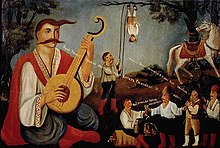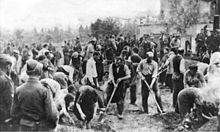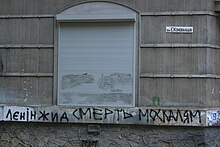Antisemitism is hostility to, prejudice towards, or discrimination against Jews. This sentiment is a form of racism, and a person who harbours it is called an antisemite. Primarily, antisemitic tendencies may be motivated by negative sentiment towards Jews as a people or by negative sentiment towards Jews with regard to Judaism. In the former case, usually presented as racial antisemitism, a person's hostility is driven by the belief that Jews constitute a distinct race with inherent traits or characteristics that are repulsive or inferior to the preferred traits or characteristics within that person's society. In the latter case, known as religious antisemitism, a person's hostility is driven by their religion's perception of Jews and Judaism, typically encompassing doctrines of supersession that expect or demand Jews to turn away from Judaism and submit to the religion presenting itself as Judaism's successor faith—this is a common theme within the other Abrahamic religions. The development of racial and religious antisemitism has historically been encouraged by the concept of anti-Judaism, which is distinct from antisemitism itself.
Antisemitism has increased greatly in the Arab world since the beginning of the 20th century, for several reasons: the dissolution and breakdown of the Ottoman Empire and traditional Islamic society; European influence, brought about by Western imperialism and Arab Christians; Nazi propaganda and relations between Nazi Germany and the Arab world; resentment over Jewish nationalism; the rise of Arab nationalism; and the widespread proliferation of anti-Jewish and anti-Zionist conspiracy theories.

A pogrom is a violent riot incited with the aim of massacring or expelling an ethnic or religious group, particularly Jews. The term entered the English language from Russian to describe 19th- and 20th-century attacks on Jews in the Russian Empire. Similar attacks against Jews which also occurred at other times and places became known retrospectively as pogroms. Sometimes the word is used to describe publicly sanctioned purgative attacks against non-Jewish groups. The characteristics of a pogrom vary widely, depending on the specific incident, at times leading to, or culminating in, massacres.
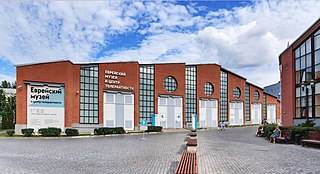
The history of the Jews in Russia and areas historically connected with it goes back at least 1,500 years. Jews in Russia have historically constituted a large religious and ethnic diaspora; the Russian Empire at one time hosted the largest population of Jews in the world. Within these territories, the primarily Ashkenazi Jewish communities of many different areas flourished and developed many of modern Judaism's most distinctive theological and cultural traditions, while also facing periods of antisemitic discriminatory policies and persecution, including violent pogroms. Some have described a "renaissance" in the Jewish community inside Russia since the beginning of the 21st century; however, the Russian Jewish population has experienced precipitous decline since the dissolution of the USSR which continues to this day, although it is still among the largest in Europe.
The Organisation of Ukrainian Nationalists was a Ukrainian nationalist organisation established in 1929 in Vienna, uniting the Ukrainian Military Organization with smaller, mainly youth, radical nationalist right-wing groups. The OUN was the largest and one of the most important far-right Ukrainian organizations operating in the interwar period on the territory of the Second Polish Republic.

The history of the Jews in Ukraine dates back over a thousand years; Jewish communities have existed in the modern territory of Ukraine from the time of the Kievan Rus'. Important Jewish religious and cultural movements, from Hasidism to Zionism, arose there. According to the World Jewish Congress, the Jewish community in Ukraine constitutes Europe's third-largest and the world's fifth-largest.
This is a list of countries where antisemitic sentiment has been experienced.

The All-Ukrainian Union "Freedom", commonly known as Svoboda, is an ultranationalist political party in Ukraine. It has been led by Oleh Tyahnybok since 2004.

The Lviv pogroms were the consecutive pogroms and massacres of Jews in June and July 1941 in the city of Lwów in German-occupied Eastern Poland/Western Ukraine. The massacres were perpetrated by Ukrainian nationalists, German death squads (Einsatzgruppen), and urban population from 30 June to 2 July, and from 25 to 29 July, during the German invasion of the Soviet Union. Thousands of Jews were killed both in the pogroms and in the Einsatzgruppen killings.
Antisemitism —prejudice, hatred of, or discrimination against Jews—has experienced a long history of expression since the days of ancient civilizations, with most of it having originated in the Christian and pre-Christian civilizations of Europe.
Antisemitic incidents escalated worldwide in frequency and intensity during the Gaza War, and were widely considered to be a wave of reprisal attacks in response to the conflict.
The February Revolution in Russia officially ended a centuries-old regime of antisemitism in the Russian Empire, legally abolishing the Pale of Settlement. However, the previous legacy of antisemitism was continued and furthered by the Soviet state, especially under Joseph Stalin. After 1948, antisemitism reached new heights in the Soviet Union, especially during the anti-cosmopolitan campaign, in which numerous Yiddish-writing poets, writers, painters and sculptors were arrested or killed. This campaign culminated in the so-called Doctors' plot, in which a group of doctors were subjected to a show trial for supposedly having plotted to assassinate Stalin. Although repression eased after Stalin's death, persecution of Jews would continue until the late 1980s.
Antisemitism in Turkey refers to acts of hostility against Jews in the Republic of Turkey, as well as the promotion of antisemitic views and beliefs in Turkey.
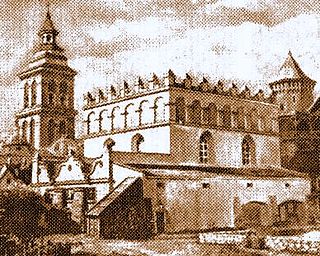
Eastern Galicia was the heartland of the medieval Kingdom of Galicia–Volhynia, currently spread over the provinces of Lviv, Ivano-Frankivsk, and Ternopil in modern western Ukraine. Along with Poles and Ukrainians, Jews were one of the three largest ethnic groups in Eastern Galicia with almost 900,000 people by 1910. From the late 18th century until the early 20th century eastern Galicia had the largest concentration of Jews of any region in Europe.
Antisemitism in Russia is expressed in acts of hostility against Jews in Russia and the promotion of antisemitic views in the Russian Federation. This article covers the events since the dissolution of the Soviet Union. Previous time periods are covered in the articles Antisemitism in the Russian Empire and Antisemitism in the Soviet Union.
Anti-Jewish boycotts are organized boycotts directed against Jewish people to exclude them economical, political or cultural life. Antisemitic boycotts are often regarded as a manifestation of popular antisemitism.
Antisemitism in Greece manifests itself in religious, political and media discourse. The 2009–2018 Greek government-debt crisis has facilitated the rise of far right groups in Greece, most notably the formerly obscure Golden Dawn.

The 1934 Constantine riots erupted in the Algerian city of Constantine against the local Jewish population, rooted in the different manner in which Jews and Muslims had been treated in Algeria by the French colonial government. It is uncertain what the exact cause of the riots was, though various accounts suggest that the riots were triggered by an altercation between a Jewish man and some Muslims at the Sidi Lakhdar Mosque in Constantine. Multiple sources report that 25 Jews and 3 Muslims died over the course of the three-day riot, and several Jewish establishments were pillaged. The events have also been described as a pogrom.
Zionist antisemitism or antisemitic Zionism refers to a phenomenon in which antisemites express support for Zionism and the State of Israel. In some cases, this support may be promoted for explicitly antisemitic reasons. Historically, this type of antisemitism has been most notable among Christian Zionists, who may perpetrate religious antisemitism while being outspoken in their support for Jewish sovereignty in Israel due to their interpretation of Christian eschatology. Similarly, people who identify with the political far-right, particularly in Europe and the United States, may support the Zionist movement because they seek to expel Jews from their country and see Zionism as the least complicated method of achieving this goal and satisfying their racial antisemitism.
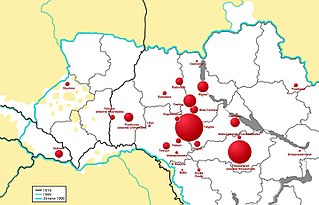
The pogroms during the Russian Civil War were a wave of mass murders of Jews, primarily in Ukraine, during the Russian Civil War. In the years 1918–1920, there were 1,500 pogroms in over 1,300 localities, in which up to 250,000 were murdered. All armed forces operating in Ukraine were involved in the killings, in particular the anti-Communist Ukrainian People's Army and Armed Forces of South Russia. It is estimated that more than a million people were affected by material losses, 50,000 to 300,000 children were orphaned, and half a million were driven out from or fled their homes. The Whitaker Report of the United Nations cited the massacre of 100,000 to 250,000 Jews in more than 2,000 pogroms which occurred during the White Terror in Russia as an act of genocide.
